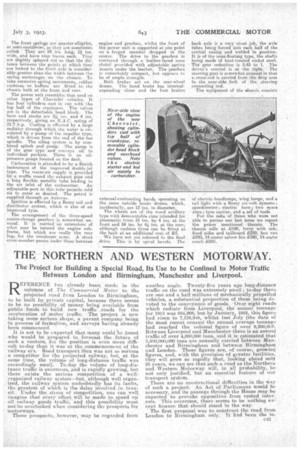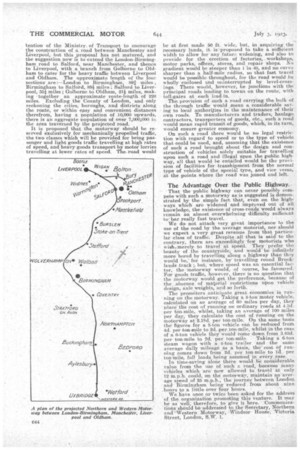THE NORTHERN AND WESTERN MOTORWAY.
Page 33

Page 34

If you've noticed an error in this article please click here to report it so we can fix it.
The Project for Building a Special Road, Its Use to be Confined to Motor Traffic Between London and Birmingham, Manchester and Liverpool.
EFERENCE has -already been made in the . :columns of The Commercial Mater to the
R ..
..projected read from 'London to .Birmingham, to be 'built-' byprivate capital, because 'there seems to he possibility of Money being available from pnblicfunds to . build . new . traffic• _roads for . the
acceleration of ,traffic. The project is now taking more serious 'shape', a parent company being in process of formation, and surVeys having already been commenced. .. .. . . .
It is not to be expected that many could be foundwho would be prepared to _forecast the future of such a venture, for the position is even more, difficult to-day than it was at the commencement of the railway era.Road transport, then was not so Serious a competitor for the projected railway, but, at the same time, the volume of long-distance traffic was exceedinglysmall. To-day the volume of long-distance traffic is enormous, and is rapidly growing, but there -existsthe serious competition of a wellorganized railway system—bat, although well organ-. ized, the railway system undoubtedly has its faults, the greatest of which is the delay, involved .in. transit.-.. Under: the. stiess of competition, one can well imagine that every effort.wilI be made to speed ill; all railway goods traffic, and. this possibility must not be overlooked when considering the prospects for
motorways. .
These prospects, .however, may be regarded from another angle. Twenty-five years ago long-distance traffic ori the road was extremely small ; to-day there are one and a half millions of mechanically propelled . vehicles, a substantial proportion of these being devoted to the con,ycyance of goods. -Over eight roads which radiate from Liverpool, the annual tonnage for 1913 was 884,208; but by January. 1922, this figurehad riaen to 7,138,248, whilst last July (the date of the most recent census) the annual average tonnage had reached the colossal figure of over 9,250,04i0. Between Liverpciol and Manchester there is an annual traffic of over 4,000,000 ions, and it is estimated that 2,500,000,000 tons are annually carried Eetween Manchester and Birmingham and between' Birmingham and London. These figures are, of course, growing figures, and, with the provision of greater facilities, ft-ley will grow so rapidly that, looking ahead only 25 years, we can see that such a road a.s the Northern and -Western Motorway will, in all probability, be not only justified, but an essential feature of our transport system. There are no constructional difficulties in the way of such a project. An Act of Parliament would be necessary, and its passage through the House may be expected to provoke opposition from vested interests. This overcome, there seems to be nothing ex'cent finance that should stand in the 'way.
The first proposal was to construct the road from London to Birminghain only. It had been the in
tention of the Ministry of Transport to encourage the construction of a road between Manchester and Liverpool, but this _proposal has not matured, and the suggestion now is to extend the London-Birmimgham road to Salford, near Manchester, and thence to Liverpool, with a branch from Golborne to Oldham to cater for the heavy traffic between Liverpool and Oldham. The approximate length of the four sections .are:—London to Birmingham, 891 miles , Birmingham to Salford, 894 miles ; Salford to Liverpool, 354 miles; Colborne to Oldham, 214 miles, making together an approximate route-length of 226 miles. Excluding the County of London, and only reckoning the cities, boroughs, and districts along the route, or within easy and convenient distances therefrom, having a population of 10,000 upwards, there is an aggregate population of over 7,000,000 in the area traversed by the projected road.
It is proposed that the motorway should be reserved exclusively for mechanically propelled traffic, the two classes which will be provided for being passenger and light goods traffic travelling at high rates of speed, and heavy goods transport by motor lorries travelling at lower rates of speed. The road would be at first made 50 ft. wide, but, in acquiring the necessary lands, it isTproposed to take a sufficient width to allow for any future, widening, and also to provide for the erection of factories, workshops,
motor parks, offices, stores, and repair shops. No gradient would be steeper than 1 in 40, and no curve
sharper than a half-mile radius, so that fast travel would be possible throughout, for the road would be wholly enclosed and uninterrupted by level-crossings. There would, however, be junctions with the principal roads leading to towns on the route, with tollgates at each lead-in. The. provision of such a road carrying the bulk of the through traffic would mean a considerable saving to local authorilies in the maintenance of their own roads. To manufacturers and traders, haulage contractors, transporters of goods, etc., such a road would mean rapid transit.of goods, which, in its turn, would ensure greater economy.
On such a road there would be no legal restriction with regard to speed or to the type of vehicle that could be used, and, assuming that the existence of such a road brought about the design and construction of vehicles solely suitable for travelling upon such a road and illegal upon the public highway, all that would be entailed would be the provision of facilities for transhipment from the normal type of vehicle of the special type, and viceversa, at the points where the road was joined and left.
The Advantage Over the Public Highway.
• That 'the public highway can never possibly Compete with such a Motorway as-is suggested 'is demonstrated by the simple fact that. even on the highways, which are widened'and improved out of all knowledge, the existence of cross-roads would always remain an almost overwhelming difficulty sufficient to' bar really fast travel.
We do not attach very great -importance to the use of the road by the average. motorist, norshould we expect a very great revenue from that particular class of traffic. Despite.all that is said to the contrary, there are -exceedingly -few motorists who wish, merely to travel ktt speed. They prefer the beauty of the countryside, and would be infini.tely more bored by travelling along a highway than they would be, for instance, by travelling round Brooklands track ;, hut, where speed was an essential factor, the motorway would, of course, be .favoured. For goods traffic, however, there is no question that the motorway would get the preference, because of the ,a,bsence of material restrictions upon vehicle design, axle weights, and so forth. The promoters anticipate great economies ' in running on the motorway. Taking a 41oir inotor vehicle, calculated on an average of 60 miles per day, they place-the Cost of running on ordinary roads at 4.3d, . per ten-mile, whilst: taking an average of 100 miles per day, they calculate the cost of running on the motorway at 2.18d. per ton-mile. On the same basis the figures for a 5-ton vehicle can be reduced from 4d. per .ton-mile to 2d. per ton-mile, whilst in the case of a 6-ton vehicle they would come down from .3.83d. per ton-mile to 2d. per ton-mile. Taking a 6-ton steam wagon with a 4-ton trailer and the same average daily mileage as a basis, the* cost Of funning comes down from 2d. per ton-mile to Id : per to/11mile, full loads being assumed in every. case. In time-saving alone there would ho coSiderable value, from the Use of such a road, because Many velaieles which are now allowed to travel 'At only 12 M.p.h. could, on the motorway, maintain an average speed of 25 m.p.h., the journey between London and Birmingham being reduced'. from about nine .hours to a little over four hours. We have once or twice been asked for the address of the organization promotingthii venture. It may . be as well, therefore, to give it here. CiammtinicatiOn$' should be andresied to thnSeeretary, Northern and-Western Motorway, Windsor House, 'Victoria Street, London, S.W. 1.














































